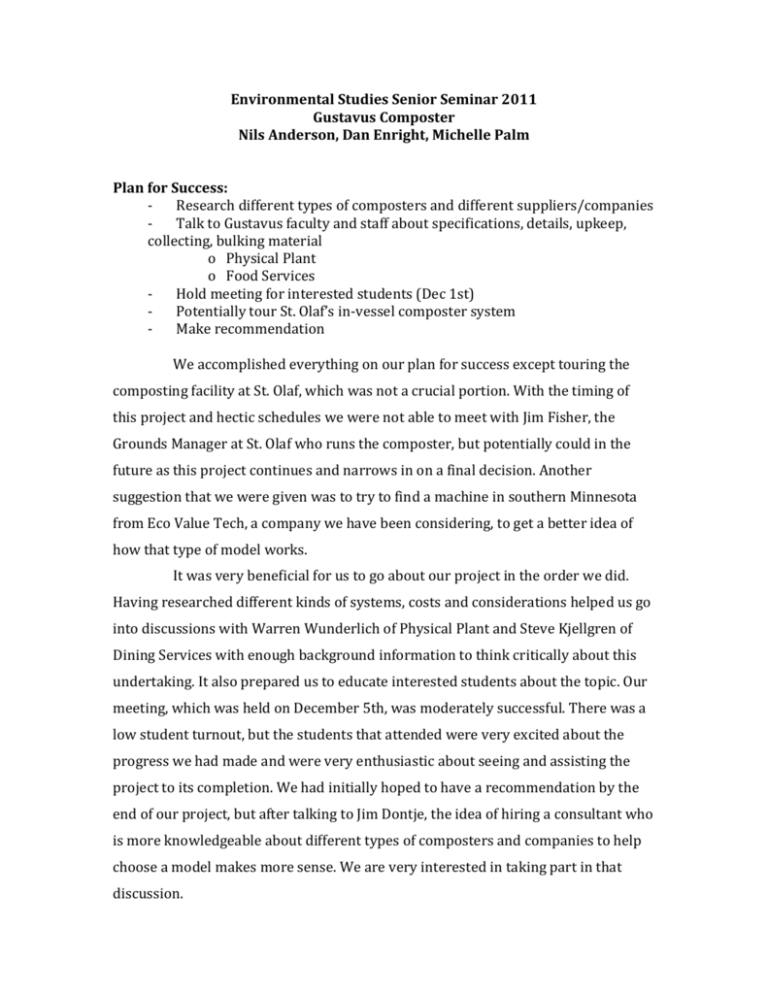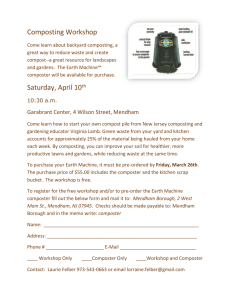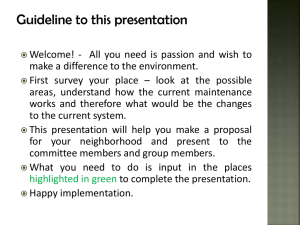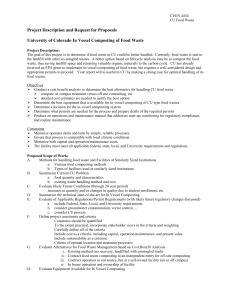Environmental Studies 2011 Senior Seminar project report
advertisement

Environmental Studies Senior Seminar 2011 Gustavus Composter Nils Anderson, Dan Enright, Michelle Palm Plan for Success: Research different types of composters and different suppliers/companies Talk to Gustavus faculty and staff about specifications, details, upkeep, collecting, bulking material o Physical Plant o Food Services Hold meeting for interested students (Dec 1st) Potentially tour St. Olaf’s in-vessel composter system Make recommendation We accomplished everything on our plan for success except touring the composting facility at St. Olaf, which was not a crucial portion. With the timing of this project and hectic schedules we were not able to meet with Jim Fisher, the Grounds Manager at St. Olaf who runs the composter, but potentially could in the future as this project continues and narrows in on a final decision. Another suggestion that we were given was to try to find a machine in southern Minnesota from Eco Value Tech, a company we have been considering, to get a better idea of how that type of model works. It was very beneficial for us to go about our project in the order we did. Having researched different kinds of systems, costs and considerations helped us go into discussions with Warren Wunderlich of Physical Plant and Steve Kjellgren of Dining Services with enough background information to think critically about this undertaking. It also prepared us to educate interested students about the topic. Our meeting, which was held on December 5th, was moderately successful. There was a low student turnout, but the students that attended were very excited about the progress we had made and were very enthusiastic about seeing and assisting the project to its completion. We had initially hoped to have a recommendation by the end of our project, but after talking to Jim Dontje, the idea of hiring a consultant who is more knowledgeable about different types of composters and companies to help choose a model makes more sense. We are very interested in taking part in that discussion. Meeting Notes: Notes from Discussion with Warren - Would like to contain it the unit, “so you don’t even know it’s there” - St. Olaf: 20-30% more meals/day o Revenue neutral? Doubtful o Issues with soup bones - Man power: Student position would work well (students already care for recycling and other duties) - Locations: o Motorpool: convenient, close to cafeteria, physical plant and Big Hill Farm. Close to electricity and water. o Burn Pile: In arboretum, where we compost yard waste. Remote so odor and vermin wouldn’t be an issue. Zoned in the country so building/permits wouldn’t be as large an issue. Lacking access to water and electricity. - Building: Zoning regulations, permits, college-only inputs - Interested in: o Compost tea –switching from chemical fertilizer? o Pre-sorting techniques o Heat from composting –what we could do with surplus heat, especially in the winter - Any Eco Value Tech machines in Southern, MN? Notes from Steve Kjellgren - How much waste per day? (Steve took us into the kitchen and we weighed a pound of post solamat food waste to make some estimations) o 120-150 gal/day on full production o 450-600 lbs post solamat & about the same raw pre-consumer - Cafeteria plastics/other wastes o Change coffee and cold drink cups to something compostable; wax or poly? o Compostable straws? A little more expensive but worth it. - Would like to see a proposal to Kitchen Cabinet - Questions: o Site? Site preparations? o Noise? o How does it get into the machine? How does St. Olaf do it? Composter Choice Considerations: - Amount of food waste - Gustavus is currently producing an estimated 600 to 1000 lbs of pre and post consumer food waste every day from the cafeteria. - Bulking Material (Carbon Material) - Many different products could function as a bulking material, plenty of which are readily available directly from the campus itself that would be available free of charge, including: clippings collected by physical plant from around campus and the arboretum, cardboard boxes from food supplies already shipped to campus, and recycled paper collected in the cafeteria. If the demand for bulking material is greater than what Gustavus is able to collect from resources already available on campus, it would be relatively easy to locate a bulking material source from a local provider. Potential sources could include wood chippings from a lumber yard such as St. Peter Lumber or trimmings from a lawn care service. - Location/Space Available - Two primary choices for the eventual composter location have been examined. The first possibility is behind the northwest corner of the Linnaeus Arboretum where there is currently some basic windrow composting being done. This site has the advantage that any foul odors coming from the composter would be less of an issue since there are no other buildings close by. Also, because this area is outside of city limits, building regulations and permitting are less stringent. On the downside, both electrical and water lines would need to be run out to this location. Also, during the winter, there would be the additional need to clear snow from the road to be able to bring food scraps and bulking material to the machine. The other option is near the motor pool, just south of the Physical Plant building. This location has the advantages of readily available power and water and less snow removal when compared to behind the arboretum. But this location is within fairly close proximity to a church across the street, estimated to be around 800 feet away, so odor would need to be controlled. This is addressed further below in the ‘Odor/Neighbors’ section. - Electricity (Power) - From preliminary research, most composters appear to use little to no energy. One quote from Eco Value Tech (a composting company who’s products we have examined) estimated that their composter only required about $0.25 worth of electricity a day. - Batch vs Continuous Feed - As Gustavus is constantly producing food scraps at a high volume, no batch style composters have been identified that would handle all of the food scraps and bulking material. Continuous feed composters are produced in sizes that can easily accommodate the amount of inputs Gustavus is producing, ranging up to 5000 lbs a day, far more than what the school would need. - Curing Space - Once food scraps have been run through the composter, additional time is needed to allow the compost to mature or to cure. All that is required for this is a dry space where they are allowed to sit for at least two more weeks. This space could easily be incorporated into a structure built to house the composter or have a lean-to built along the outside of the structure to protect the curing compost from the elements. - Upkeep/Maintenance - A professional grade composter such as the ones that are being examined generally require little maintenance. Composter producers generally include a warranty to guarantee the parts. - Odor/Neighbors - While composting can produce some off odors, if the correct balance between food scraps and bulking material is maintained, there should be negligible smell. We have found in-vessel composting units that incorporate insulation that is designed to contain smell. Additionally, if a structure was built to contain the composter, this would further help to contain odors. - Cost - Cost of composting units can vary widely. Naturally, when selecting a composter, we will not only try to find the lowest priced option, but will rather choose the one that provides the most benefit at the most competitive price. - Amount of compost produced - After the food scraps and bulking material has gone through the composter, its overall mass will have decreased by approximately a third. - Who runs the unit - Several options exist including: a physical plant employee incorporating the running of the unit into their existing duties, the creation of a new student job, or having student volunteers run the unit. - Educating student body on composting - We feel it would help the success of this project to get as much of the student body in support of composting on campus as possible. - Trash/Non-compostables in machine - Steps must be taken to assure that as little non-compostable waste ends up entering the compost as possible. Possible solutions include setting up a station near the tray line in the cafeteria where students could pre-sort their plastics (such as drinking straws) into a separate bin that will not be put into the composter. - Continued student growth- Gustavus has continued to grow recently and will likely expand at least moderately in the future. The eventual unit decided upon will account for this growth so that Gustavus can continue to utilize all of its food waste into the future. Tentative Proposed Unit: - Eco Value Tech - Low energy (2hp motor, approx. $0.25/day) - Contained (low to zero smell, likely no vermin) - Compact in size and design (some other units require large buildings) - Quick (4-14 days in composter, plus curing time) - Fairly local (Michigan) - Minimal labor (does not need constant supervision, has the option for lift unit to load waste into machine) - Competitively priced Definition of Completion: - A recommendation for a specific type of composter and why it would best benefit the Gustavus campus in comparison to others. - Solid input and commitment from someone that they would take part in running the composter. While we have a tentative recommendation for a composter, we are not comfortable to make a final decision yet. We have learned a lot in this process, but, as mentioned, a consultant would be very beneficial in helping us to choose a composting machine and we will hold off on making a final recommendation to the Environmental Studies department until we have met with a hired consultant. Beyond that, we have gotten solid input and commitment from both Warren Wunderlich and Steve Kjellgren to see this through and help take part in running it. This support is crucial for a major project like this to be implemented on campus. Plans for Continuing this Project: 1) Explore other composting projects in the region; this will help us to consider other options as well as foresee future barriers we may encounter by analyzing other composting systems; we plan on visiting composting locations over the month of January. 2) Identify and contact a consultant to visit Gustavus and analyze our waste system; this will provide us with a valuable perspective since the consultant will be an expert on the topic and has much more experience with composting projects; we are planning on contacting a consultant at the first available date, but need approval first. 3) Assembling a small group of Gustavus faculty and staff who have a vested interest in the composting project; propose several ideas/scenarios involving the composting unit and potentially some sort of structure (hoop house, greenhouse, shed, etc.); we are planning to assemble this group during J-term, but the discussion won’t occur until we talk with the consultant and determine the type of composting unit we think is best. 4) Come to a conclusion on which composting unit the school should purchase as well as the type of structure (should we need one) and how the system will function; this conclusion will be presented first to the ES department and Warren Wunderlich, then to the Kitchen Cabinet, and finally to any other interested groups or individuals. Not only have we learned the ins and outs of composting, whether it be in windrows, vermicomposting or in-vessel machines, but also a great deal about food waste processes at Gustavus and other institutions. It has been interesting to get many perspectives on the topic, since there are a number of diverse interests represented in this discussion. We have gathered useful opinions, information and suggestions from Environmental Studies faculty, physical plant, dining services and students. We’ve discovered that as we pursue a recommendation, we continue to find more information and options available to us which pushes us further from our final decision. However, this is certainly not a bad occurrence since it will inevitably improve the quality of our choice. The three of us commit to pursuing the completion of this project into the Spring Semester to see it through!








